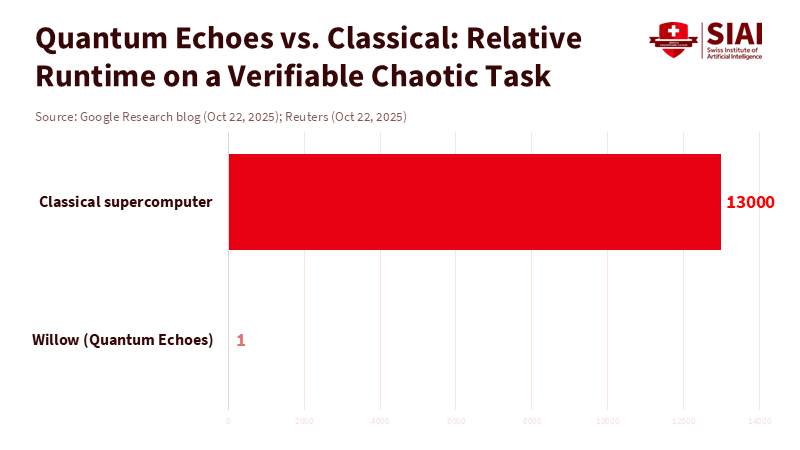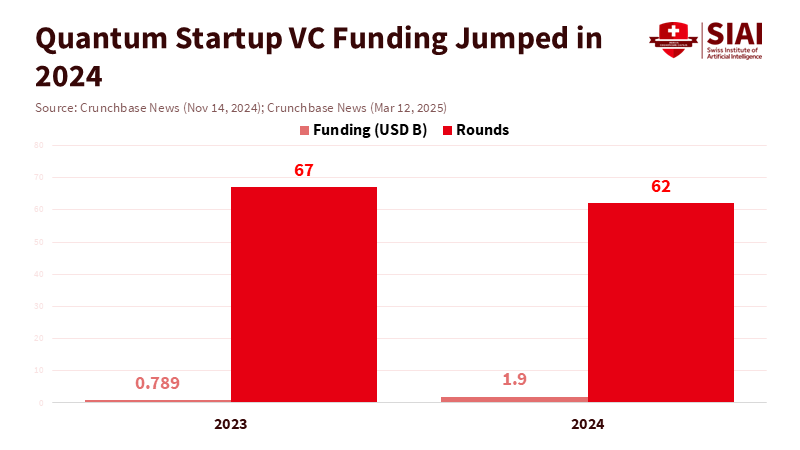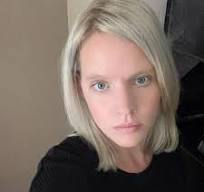From Hype to Syllabus: Quantum Chaos Education After Google’s “Echoes” Claim
Input
Modified
Quantum Echoes delivered a verified 13,000× speedup, elevating quantum chaos education Curricula should pivot from qubit counts to competence in echoes, OTOCs, and noise Fund teacher PD, simple cloud labs, and artifact-based assessment

If a single experiment can change a field’s priorities, the recent “Quantum Echoes” result may be that moment. Google’s Willow chip reportedly completed an out-of-time-order correlator task about 13,000 times faster than the best classical method, with a result that can be verified—not just accepted. This means that the Willow chip's performance is not just a claim, but a fact that can be proven through repeated experiments. That speedup is impressive, but the real change lies in what it measures: how information mixes in many-body systems, the essence of quantum chaos education. This result, if it stands, could revolutionize the way we approach quantum computing education. The most crucial lesson for schools and universities is not “add more qubits,” but “teach how we verify chaotic behaviors and turn them into useful signals.” Verification alters incentives. It supports curricula focused on chaos diagnostics, noise-aware design, and reproducible workflows. It also gives students a clear message: we can now explore the edge of quantum ergodicity in the lab, not only in lectures. The question shifts from whether quantum chaos “exists” in some abstract way to whether our education systems are prepared to teach it effectively and quickly.
Why quantum chaos education matters now
The shift from counting qubits to demonstrating verifiable advantage is primarily an education concern before it becomes an industry issue. The 'Quantum Echoes' experiment, which employs correlators that track how information spreads through interacting qubits, is a significant development in this shift. These out-of-time-order correlators (OTOCs) and Loschmidt echoes have long been suggested as practical indicators of chaotic dynamics, but measuring them at meaningful scales has been challenging. The Willow result is significant because it connects those measures to a task that classical machines struggle to simulate. Yet, the outcome can be verified by independent runs or systems. This is what education has been trying to achieve: introduce chaos not as a metaphor, but as a measurable, curriculum-ready concept that links theory to practice without requiring million-qubit machines. When students see that a correlator can enable a computation beyond classical reach and remain verifiable, they learn the right instinct: to pursue functional structure rather than just headline numbers.
Formal curricula are still catching up. In K-12 and early undergraduate programs, teachers report feeling unprepared to teach quantum topics and lacking preparation time. A 2024 study involving 49 teachers found strong interest but uneven knowledge; a 12-hour professional-development model for educators showed promise but has not yet reached a larger scale. Meanwhile, the U.S. Q-12 initiative and Europe’s Quantum Flagship are creating resources, communities, and skill frameworks. These programs are essential as they help schools teach chaos through concrete lab tasks: simple echo experiments on simulators, entry-level OTOC estimators on cloud platforms, and guided lessons on scrambling, reversibility, and noise. Once verification is part of the discussion, assessment becomes easier too. Students can run small circuits, test decay patterns, and evaluate themselves against reference traces—precisely the kind of objective evidence policymakers want when they finance new educational paths.

From qubit counts to competence
For a decade, the primary metric has been qubits. This made sense when devices were small and gradual growth was noteworthy. But a verified, chaos-based speedup shifts the focus: competence over count. Competence means students can model noise, design reversible pulse sequences, and understand information scrambling in circuits. It means they know why a Loschmidt echo decays and how to interpret an OTOC time series. It also means they realize that “chaos” in this context isn’t the classical butterfly-effect disorder; it’s the controlled growth of operators in many-body quantum systems, as seen in specific correlators. Viewing chaos as a resource demystifies the field. It directs students toward measurement design, error pathways, and data validation—skills that apply to sensing, materials, and even AI benchmarking, where quantum-generated datasets might supplement classical ones. Education programs that continue to teach qubits as if bigger always means better will miss what labs are currently measuring.

Competence must also match workforce needs. The Quantum Economic Development Consortium (QED-C), a global initiative focused on advancing quantum technology, estimates thousands of job openings globally, spanning software tooling, control engineering, cryogenics, and curriculum development—positions that don’t require a PhD in physics. McKinsey forecasts that quantum computing will be worth tens of billions by the mid-2030s; QURECA, a consultancy firm specializing in quantum technologies, estimates that public investments in quantum now exceed $55 billion worldwide. The risk is clear: we grow research budgets faster than we expand talent pipelines. That gap widens if programs focus on device specifications rather than verifiable tasks that students can actually perform. “Quantum chaos education” provides a solution. It grounds theory in reproducible experiments and clear standards. It shows policymakers that small, affordable steps—such as teacher professional development, cloud-QPU vouchers, and accessible lab modules—lead to measurable learning and job readiness. The goal is not to produce more theorists; it’s to graduate many more practitioners who understand noise and verification.
Quantum chaos education in practice
Redesigning courses to incorporate quantum chaos education doesn't have to be daunting. Start with an introductory sequence that replaces one abstract unit on 'measurement' with a practical lab on echoes and scrambling. Students will build a minimal circuit, introduce a reversible change, and chart a decay curve. In the second lab, they will estimate a simple OTOC and analyze the slope and saturation. In the third lab, they will compare the simulator output with results from a noisy backend and discuss differences. This sequence not only achieves educational goals but also establishes a culture of verification, all without the need for elite hardware; low-depth circuits on accessible cloud devices are adequate. The focus is on thinking with correlators, not on maximizing depth.
Teacher preparation is the key limiting factor. Data indicates that most teachers want to explore quantum topics but need concise, practical training. The solution is to scale proven micro-credentials—short, 10 to 15-hour modules that combine content reviews with ready-to-use labs. Professional development should not depend on specific hardware and should align with competence frameworks (for example, Europe’s updated CFQT profiles). School districts can collaborate with national programs like Q-12 for materials and with local universities for office-hour support and open lab days. Funders should link grants to verifiable student outputs: a plotted echo with metadata, an OTOC notebook with straightforward interpretations, and a brief reflection on sources of noise. These outputs will create the evidence base that budget committees and boards need. They also build the foundations of a student portfolio that employers can quickly grasp.
Addressing skepticism and guarding against hype
Skepticism is healthy, and quantum chaos draws much of it. Some argue that there is no “true” quantum chaos in the classical sense; others worry that correlators show simulation difficulty but not usefulness. Both critiques help refine our teaching. First, we should clarify our terms: in this context, “chaos” refers to operator growth and information scrambling, as captured by correlators such as OTOCs and Loschmidt echoes. Second, verification is crucial. Even advocates acknowledge that cross-platform checks are still limited; independent groups need to reproduce the task across different devices. That is the moment to teach students scientific humility. We can celebrate a 13,000× speedup while also teaching that it is task-specific, hardware-dependent, and awaiting broader replication. Students should learn to differentiate between “beyond classical reach today” and “general quantum usefulness tomorrow.”
Guarding against hype requires setting clear policy boundaries. Education leaders should avoid curricular changes that react to each press release. Adoption should depend on three criteria: verifiability on available hardware, clear connections to workforce skills, and assessments that produce tangible outputs, not just grades. The Willow result meets all three criteria when properly framed. Verifiability is inherent in the correlators. Workforce skills include noise modeling, experimental design, and data management—skills applicable beyond quantum computing to sensing, materials, and AI processes. Assessment can be based on tangible outputs, which aligns with many systems that already favor competency-based education reforms. At the same time, leaders should inform stakeholders about transitions in cryptography. The same progress that enables echoes also accelerates the need for post-quantum cryptography; curricula must clarify why standards are changing and how students can prepare now.
The biggest takeaway from “Quantum Echoes” isn’t the speedup; it’s that verification is now part of the narrative. That is what education needs. When a measurement of chaotic dynamics can be both beyond classical limits and checkable, we gain a framework for teaching quantum mechanics in a lasting way. Start with small, practical labs on echoes and scrambling. Train teachers through short, credentialed modules. Assess what students can reproduce and explain. Invest in access, not just hardware. The outcome is a generation that can distinguish between signal and noise, and promise and hype. They will understand why an echo decays, when an OTOC is essential, and how to design experiments that secure their skills for the future. If a single statistic should guide policy, let it be the one that counts: a verified task that drives curricula to evolve. That is how quantum chaos education transitions from headlines to routines—quickly and sustainably.
The views expressed in this article are those of the author(s) and do not necessarily reflect the official position of the Swiss Institute of Artificial Intelligence (SIAI) or its affiliates.
References
Ars Technica. (2025, October 22). Google has a practical quantum algorithm that outperforms supercomputers.
García-Mata, I., Jalabert, R. A., & Wisniacki, D. A. (2022). Out-of-time-order correlators and quantum chaos. arXiv:2209.07965.
Google Research. (2025, October 22). A verifiable quantum advantage.
Google Research—The Keyword. (2025, October 22). Neven, H., & Smelyanskiy, V. Our Quantum Echoes algorithm is a big step toward real-world applications for quantum computing.
Holincheck, N., et al. (2024). Quantum science and technologies in K-12: Supporting teachers to integrate quantum in STEM classrooms. Education Sciences, 14(3), 219.
Kelly, A. M., et al. (2024). Quantum information science and technology professional development for preservice and in-service secondary educators. Physical Review Physics Education Research, 20, 020154.
McKinsey & Company. (2024, April). Quantum Technology Monitor.
Nature. (2025, October 22). Observation of constructive interference at the edge of quantum ergodicity (Google Quantum AI and Collaborators).
QED-C (Quantum Economic Development Consortium). (2025, June 24). Report recommends ways to strengthen the quantum talent pipeline.
Q-12 Education Partnership. (n.d.). Growing the quantum workforce.
QURECA. (2025, October 15). Quantum Initiatives Worldwide 2025.
Reuters. (2025, October 22). Google says it has developed landmark quantum computing algorithm.
Scientific American. (2025, October 22). ‘Quantum Echoes’ on Google’s Willow chip.
ScienceNews. (2025, October 22). Quantum ‘echoes’ reveal the potential of Google’s computer.
Scholarpedia. (2024, December 27). Out-of-time-order correlations and quantum chaos.
Tom’s Hardware. (2025, October 22). Google’s Quantum Echo algorithm shows world’s first practical application of quantum computing.
Quantum Flagship (EU). (2025). Publications and competence frameworks.





















